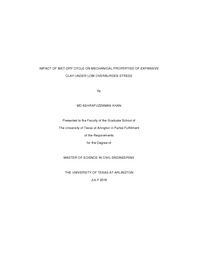
ATTENTION: The works hosted here are being migrated to a new repository that will consolidate resources, improve discoverability, and better show UTA's research impact on the global community. We will update authors as the migration progresses. Please see MavMatrix for more information.
Show simple item record
| dc.contributor.advisor | Hossain, Sahadat | |
| dc.creator | Khan, Md Ashrafuzzaman | |
| dc.date.accessioned | 2016-10-25T19:29:19Z | |
| dc.date.available | 2016-10-25T19:29:19Z | |
| dc.date.created | 2016-08 | |
| dc.date.issued | 2016-09-16 | |
| dc.date.submitted | August 2016 | |
| dc.identifier.uri | http://hdl.handle.net/10106/26124 | |
| dc.description.abstract | The seasonal variation in the water content termed as drying-wetting cycle is one of the most important environmental factor that may cause the degradation of strength for expansive clay. Highway embankment within the north Texas region are mostly constructed on expansive clay and shallow slope failures pose a significant maintenance problem for the Texas Department of Transportation (TxDOT). Understanding the strength loss mechanism of the expansive clay will provide some useful guidelines to design embankment with adequate factor of safety for long term drained condition. Impact of wet-dry cycle on the high plastic clay strength was measured by several researchers (Rogers and Wright, 1986; Wright et al. 2007) but the impact of wet dry cycle at low overburden stress (< 50 kPa) was not clarified, which might lead to the surficial slope failure.
In this study soil samples collected from two different slope location (DFW, Texas) with different liquid limits (LL = 40 and LL = 80) were used for the determination of shear strength parameters for 1, 3 and 5 number wet-dry cycle. Density, void ratio, moisture contents were also determined for the same number of cycles. Experimental results indicate that, for the low plastic clay changes in void ratio for the first, third and fifth cycle were 44.5%, 54.6% and 57.9% respectively. Similar trend was observed for the high plastic clay where the changes in void ratio for the first, third and fifth cycle were 44.7% ,52.0% and 55.0% respectively. Increase in moisture content for the low plastic clay for the first, third and fifth cycles were 51.3%, 63.6% and 68.7% respectively whereas for the high plastic clay the increments were 42.6%, 52% and 56.8%. Angle of internal friction (drained condition) for the low plastic clay reduced from 33.0o to 19.30 but the cohesion increased from 2.83 kPa to 5.16 kPa after the fifth cycle. But for the high plastic clay angle of internal friction (drained condition) reduced from 28.8o to 23.0o and cohesion decreased from 4.5 kPa to 2.1 kPa, after the fifth cycle of wetting and drying. | |
| dc.format.mimetype | application/pdf | |
| dc.language.iso | en_US | |
| dc.subject | Expansive clay | |
| dc.subject | Wet-dry cycle | |
| dc.title | IMPACT OF WET-DRY CYCLE ON MECHANICAL PROPERTIES OF EXPANSIVE CLAY UNDER LOW OVERBURDEN STRESS | |
| dc.type | Thesis | |
| dc.degree.department | Civil Engineering | |
| dc.degree.name | Master of Science in Civil Engineering | |
| dc.date.updated | 2016-10-25T19:30:23Z | |
| thesis.degree.department | Civil Engineering | |
| thesis.degree.grantor | The University of Texas at Arlington | |
| thesis.degree.level | Masters | |
| thesis.degree.name | Master of Science in Civil Engineering | |
| dc.type.material | text | |
Files in this item
- Name:
- KHAN-THESIS-2016.pdf
- Size:
- 1.747Mb
- Format:
- PDF
This item appears in the following Collection(s)
Show simple item record


